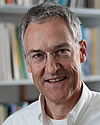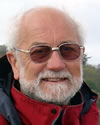2015 Honorary Fellows
Presented to Manfred Strecker and Brian Windley

Manfred Strecker
Germany
Dr. Manfred Strecker’s research activities link studies of tectonics, climate, and landscape evolution with the goal to better understand tectonic and climatic forcing mechanisms of surface processes and their conspiring activity in sculpting the surface of our planet. In particular, he and his team have worked to better understand how the morphology of landscapes can be used to reconstruct crustal deformation processes and to bridge the temporal gap between long-term geologic manifestations of deformation and short-term observations and instrumental measurements. By joint application of morphometric analyses, neotectonic observations, paleoseismology, surface exposure dating, and thermochronological methods, they have successfully deciphered tectonic and climatic signals within sedimentologic archives and within the context of landscape evolution. This work has been carried out in various mountain belts, including the Andes, the Himalaya, Central Asia and the ranges bordering the Turko-Iranian Plateau. He and his team also focus on stress-field histories in the context of the structural development of linked fault systems and their impact on the evolution of sedimentary basins in the East African Rift.
Strecker did his undergraduate work at Göttingen University (Germany) and the University of North Carolina at Chapel Hill. He received his MSc degree at Cornell University in 1983 and his PhD from the same university in 1987. After postdoc appointments at University of Karlsruhe (Germany) and Stanford University, he joined the University of Potsdam (Germany) in 1995. Since then, he and his colleagues have been responsible for establishing a geoscience program with a strong research-based curriculum. Strecker was Visiting Professor at Vienna University, IPG Paris, and Stanford University. Since 2009 he has also been Adjunct Professor at Cornell University. He is a member of Leopoldina, the German Academy of Sciences.

Brian Fred Windley
United Kingdom
Windley is a leading, pre-eminent geoscientist whose career has revolved around understanding the manifold facets of the tectonic development of orogens through geological time, and especially application of the plate tectonic paradigm to Precambrian accretionary and collisional orogens worldwide. These include: 1. Field-based studies of (a) the accretionary Central Asian Orogenic Belt/Altaids, the Mona Complex of Anglesey/Lleyn (Wales, UK), and terranes in Yemen: (b) the collisional Himalayan (Kohistan) and Karakoram orogens (Pakistan), the Tian Shan mountains (China), Sergipano belt (Brazil), Mozambique orogen (Madagascar), the Kumta-Coorg suture (SW India), and the Aravalli-Delhi belts in Rajasthan (India). 2. Geotectonic growth of deep continental crust in W. Greenland, S. India, and NW Scotland (Neoarchean), and the Ketilidian orogen in Greenland (Paleoproterozoic). 3. Tectonic uplift of Cenozoic mountains in West Mongolia, and climate-tectonic relations in Central Asia. 4. Neoproterozoic ocean plate stratigraphy and accretion in Anglesey/Lleyn, and Ballantrae, Scotland. 5. Petrology of eclogitic rocks at Glenelg, Scotland; Beishan, China; Vietnam; Kyrgyzstan, and blueschists in Anglesey and Ballantrae. 6. Chromite-layered anorthositic complexes from the roots of island arcs at Fiskenaesset (Greenland), Sittampundi (India), Chilas (Pakistan Himalayas), Limpopo (South Africa), and Chimalpahad (Eastern Ghats). 7. Tectonic development of ophiolitic complexes in Beishan, Ballantrae, Tartoq (Greenland), and Bayankhongor (Mongolia). 8. Petrology of sapphirine-bearing rocks especially at Fiskenaesset. 9. Crustal rheology and elastic thickness of the Indian Shield, and Ninetyeast Ridge (Andaman Islands). 10. Delamination of sub-continental lithosphere in eastern China. 11. Geotectonic evolution of Precambrian cratons - West Greenland and North China Craton. These projects involved collaborative fieldwork and laboratory studies with innumerable students and staff in 23 countries.
Windley has published 9 edited/co-edited books and 320 peer-reviewed papers with >19,000 citations. Syntheses of the inter-disciplinary geology of crust/mantle evolution through time integrated with the atmosphere, oceans and metallogenesis led to ‘The Evolving Continents’ in three editions.
